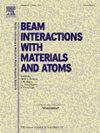Parametrization of dose profiles of therapeutic minibeams of protons, 4He, 12C, and 16O
IF 1.4
3区 物理与天体物理
Q3 INSTRUMENTS & INSTRUMENTATION
Nuclear Instruments & Methods in Physics Research Section B-beam Interactions With Materials and Atoms
Pub Date : 2025-02-01
DOI:10.1016/j.nimb.2024.165604
引用次数: 0
Abstract
Single minibeams of protons, 4He, 12C and 16O in water were modeled with Geant4, and their dose distributions were parameterized with double-Gauss–Rutherford (DGR) functions. Dose distributions from arrays of 16 parallel minibeams centered on a rectangular or hexagonal grid were constructed from the parameterized minibeam profiles to simulate the lateral convergence of the minibeams resulting in a homogeneous dose field in the target tumor volume. Peak-to-valley dose ratios (PVDR) and dose-volume histograms (DVH) were calculated for the parameterized dose distributions and compared with those obtained directly from Geant4 modeling of minibeam arrays. The similarity of the results obtained by these two methods suggests that the fast calculation of dose profiles of minibeam arrays based on the DGR parameterizations proposed in this work can replace the time-consuming MC modeling in future preclinical studies and also in the development of treatment planning systems for minibeam therapy.
质子、4He、12C和16O治疗微束剂量谱的参数化
用Geant4软件对水中质子、4He、12C和16O的单微束进行了建模,并采用双高斯-卢瑟福(DGR)函数参数化了它们的剂量分布。以参数化的微光束轮廓为基础,构建了以矩形或六边形网格为中心的16束平行微光束阵列的剂量分布,模拟了微光束的横向收敛,从而在靶肿瘤体积内形成均匀的剂量场。计算了参数化剂量分布的峰谷剂量比(PVDR)和剂量-体积直方图(DVH),并与直接从Geant4微束阵列建模得到的结果进行了比较。这两种方法得到的结果的相似性表明,基于本研究提出的DGR参数化的微束阵列剂量谱的快速计算可以在未来的临床前研究和微束治疗计划系统的开发中取代耗时的MC建模。
本文章由计算机程序翻译,如有差异,请以英文原文为准。
求助全文
约1分钟内获得全文
求助全文
来源期刊
CiteScore
2.80
自引率
7.70%
发文量
231
审稿时长
1.9 months
期刊介绍:
Section B of Nuclear Instruments and Methods in Physics Research covers all aspects of the interaction of energetic beams with atoms, molecules and aggregate forms of matter. This includes ion beam analysis and ion beam modification of materials as well as basic data of importance for these studies. Topics of general interest include: atomic collisions in solids, particle channelling, all aspects of collision cascades, the modification of materials by energetic beams, ion implantation, irradiation - induced changes in materials, the physics and chemistry of beam interactions and the analysis of materials by all forms of energetic radiation. Modification by ion, laser and electron beams for the study of electronic materials, metals, ceramics, insulators, polymers and other important and new materials systems are included. Related studies, such as the application of ion beam analysis to biological, archaeological and geological samples as well as applications to solve problems in planetary science are also welcome. Energetic beams of interest include atomic and molecular ions, neutrons, positrons and muons, plasmas directed at surfaces, electron and photon beams, including laser treated surfaces and studies of solids by photon radiation from rotating anodes, synchrotrons, etc. In addition, the interaction between various forms of radiation and radiation-induced deposition processes are relevant.

 求助内容:
求助内容: 应助结果提醒方式:
应助结果提醒方式:


